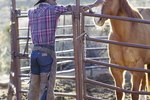Things You'll Need
2 7-foot fence posts
Post hole digger
Level
Rock bar
River rocks
1/4-inch cable sufficient to span the river
2 Cable collar and nuts and bolts
Wrenches and socket set
3-inch PVC pipe or 2 by 2-inch boards
1/2-inch PVC pipe
Drill
1/3-inch bit
Come-along
Wench
A cattle water gap –– also called a flood gate –– helps prevent cattle from going around a fence by walking through a river or body of water. Unless the bottom of the river or pond is composed of solid ground and the water is no deeper than a few feet, building a fence across it using posts isn't possible. A gap eliminates the need for posts in the water.
Dig two post holes 3 feet deep on opposing sides of the river. Drop your posts in the holes. Level them up and down, and then tamp a few inches of dirt around the bottom with the rock bar. Drop in 6 inches of river rock, then 6 inches of dirt, then rock, then dirt, vigorously tamping each layer. Layer and compact the hole around the post until it's full.
Wrap the tail of the cable around the top of one of the posts twice, 6 inches below the top. Fasten the tail of the cable to the section span the river with the collar and nuts and bolts. Span the cable across the river to the other post. Fasten it around the post, 6 inches from the top. Pull it tight with a come-along. Measure the distance from the cable to the riverbank every 5 feet, and write down your measurements in succession. You will hang 10 streamers every 5 feet with 10 spacers in between.
Cut your 1-inch PVC into 6-inch lengths. Cut your 3-inch PVC or 2 by 2-inch boards to the correct length according to your measurements. Make sure you keep each 5-foot grouping of stringers separated from every other so there is no confusion when you string them to the cable. Drill holes in each stringer, three inches from the top. This allows for a 3-inch rise in the river before the stringers begin to drag in the water.
Unfasten one side of the cable, and drag it across to the other side of the river. Thread the stringers onto the cable. Between each stringer, place a spacer –– the 6-inch pieces of 2-inch PVC. After you have the cable strung, drag it back across the river. You might have to hook a wench to it if the river gap is too wide. Wrap the cable around the post, and pull it tight with your come-along. Fasten the cable in place with the cable collar.
Tips
Use solid fence posts. These post must sustain the weight of the cable and the stringers. Put in your water gap at low water. High water usually only lasts a few months, so if you put in the gap during high season, the stringers will be too short the majority of the year. You can add a second cable at the bottom of the stringers –– with spacers –– if the river does not flood regularly or if you are not afraid of debris damaging it. This simply makes it more secure.
References
Photo Credits
-
Photos.com/Photos.com/Getty Images





